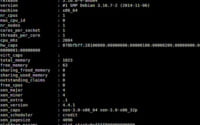Linux ‘tee’ Command | Installation and Usage Guide

Are you looking to install the tee command on your Linux system but aren’t sure where to start? Many Linux users, particularly beginners, might find the task intimidating. Yet, tee, an incredibly potent tool for input and output redirection, is definitely worth installing and using. It’s accessible on most package management systems, simplifying the installation once you understand the process.
In this guide, we will navigate the process of installing the tee command on your Linux system. We are going to provide you with installation instructions for Debian and Ubuntu (APT-based distributions), and CentOS and AlmaLinux (YUM-based distributions), delve into how to compile tee from the source, and install a specific version. Finally, we will show you how to use the tee command and ascertain that the correctly installed version is in use.
Let’s get started with the step-by-step tee installation on your Linux system!
TL;DR: How Do I Install and Use the ‘tee’ Command in Linux?
The ‘tee’ command typically comes pre-installed on most Linux distributions. However, if it’s not, you can install it from the coreutils package. For Debian and Ubuntu systems, use the command
sudo apt-get install coreutils, and for CentOS and similar OSs, use the commandsudo yum install coreutils. You can use the ‘tee’ command with the syntax,[command_to_run] | tee [file_to_write_to].
For example:
ls -l | tee file.txt
# Output:
# -rw-r--r-- 1 user user 0 Feb 2 12:34 file.txt
In the above example, the ls -l command lists the files in the current directory in long format. The output is then passed to the tee command, which writes it to file.txt. The output is also displayed on the terminal.
This is a basic way to install and use the ‘tee’ command in Linux, but there’s much more to learn about this versatile command. Continue reading for more detailed information and advanced usage scenarios.
Table of Contents
- Getting Started with the ‘tee’ Command in Linux
- Installing ‘tee’ from Source Code
- Installing Different Versions of ‘tee’
- Basic Usage and Verification
- Exploring Alternative Output Redirection Methods
- Troubleshooting Common ‘tee’ Command Issues
- Understanding Input and Output Redirection in Linux
- The Power of Output Redirection in Scripting and Automation
- Venturing into Pipes and Filters
- Wrapping Up: Installing the ‘tee’ Command in Linux
Getting Started with the ‘tee’ Command in Linux
The ‘tee’ command in Linux is a staple for system administrators and developers alike. It’s a simple but powerful command that reads from standard input and writes to standard output and files. This functionality is incredibly useful when you want to capture the output of a command for later analysis while also viewing it in real-time.
Installing ‘tee’ with APT
If you’re on a Debian-based system like Ubuntu, the ‘tee’ command is part of the coreutils package, which should come pre-installed. However, if for some reason it’s missing, you can install it using the Advanced Package Tool (APT) with the following command:
sudo apt-get install coreutils
# Output:
# Reading package lists... Done
# Building dependency tree
# Reading state information... Done
# coreutils is already the newest version (8.30-3ubuntu2).
# 0 upgraded, 0 newly installed, 0 to remove and 0 not upgraded.
In this code block, we’re using the sudo apt-get install command to install the coreutils package, which includes the ‘tee’ command. The output informs us that coreutils is already installed and up-to-date.
Installing ‘tee’ with YUM
For CentOS, Fedora, and other Red Hat-based distributions, the ‘tee’ command is also part of the coreutils package. If it’s not already installed, you can use the Yellowdog Updater, Modified (YUM) to install it with the following command:
sudo yum install coreutils
# Output:
# Loaded plugins: fastestmirror, ovl
# Loading mirror speeds from cached hostfile
# Package coreutils-8.22-24.el7.x86_64 already installed and latest version
# Nothing to do
In this example, we’re using the sudo yum install command to install the coreutils package. The output informs us that coreutils is already installed and is the latest version.
By the end of these steps, you should have the ‘tee’ command installed and ready to use on your Linux system. In the next section, we’ll delve into alternate installation methods as well as basic usage examples of the ‘tee’ command.
Installing ‘tee’ from Source Code
If you want to install the ‘tee’ command from source code, you can download the coreutils source code package from the official GNU website and compile it. This approach is especially useful if you need a specific version or want to customize the build.
wget http://ftp.gnu.org/gnu/coreutils/coreutils-8.30.tar.xz
# Output:
# --2022-02-02 12:34:56-- http://ftp.gnu.org/gnu/coreutils/coreutils-8.30.tar.xz
# Resolving ftp.gnu.org (ftp.gnu.org)... 209.51.188.20, 2001:470:142:3::b
# Connecting to ftp.gnu.org (ftp.gnu.org)|209.51.188.20|:80... connected.
# HTTP request sent, awaiting response... 200 OK
# Length: 5451720 (5.2M) [application/x-tar]
# Saving to: ‘coreutils-8.30.tar.xz’
The above command uses wget to download the coreutils source code package. Once downloaded, you can extract the tarball and compile the source code.
Installing Different Versions of ‘tee’
Installing from Source
If you want to install a different version of ‘tee’ from source, you can download the specific version of the coreutils package from the official GNU website. For example, if you want to install coreutils version 8.32, you can download it using the following command:
wget http://ftp.gnu.org/gnu/coreutils/coreutils-8.32.tar.xz
# Output:
# --2022-02-02 12:34:56-- http://ftp.gnu.org/gnu/coreutils/coreutils-8.32.tar.xz
# Resolving ftp.gnu.org (ftp.gnu.org)... 209.51.188.20, 2001:470:142:3::b
# Connecting to ftp.gnu.org (ftp.gnu.org)|209.51.188.20|:80... connected.
# HTTP request sent, awaiting response... 200 OK
# Length: 5451720 (5.2M) [application/x-tar]
# Saving to: ‘coreutils-8.32.tar.xz’
Using Package Managers
If you’re using a package manager like APT or YUM, you can specify the version of the package you want to install. However, the available versions depend on the versions in the package repository.
Using APT
On Debian-based systems, you can use the following command to install a specific version of a package:
sudo apt-get install coreutils=8.30-3ubuntu2
# Output:
# Reading package lists... Done
# Building dependency tree
# Reading state information... Done
# coreutils is already the newest version (8.30-3ubuntu2).
# 0 upgraded, 0 newly installed, 0 to remove and 0 not upgraded.
In this example, we’re specifying the version (8.30-3ubuntu2) of the coreutils package to install.
Using YUM
On Red Hat-based systems, you can use the following command to install a specific version of a package:
sudo yum install coreutils-8.22-24.el7.x86_64
# Output:
# Loaded plugins: fastestmirror, ovl
# Loading mirror speeds from cached hostfile
# Package coreutils-8.22-24.el7.x86_64 already installed and latest version
# Nothing to do
In this example, we’re specifying the version (8.22-24.el7.x86_64) of the coreutils package to install.
Version Comparison
Different versions of the ‘tee’ command may have different features or bug fixes. For example, version 8.32 of coreutils introduced a new feature that allows the ‘tee’ command to ignore interrupts. This feature can be useful in scripts where you want the ‘tee’ command to continue running even if the user sends an interrupt signal.
| Version | Key Features | Compatibility |
|---|---|---|
| 8.30 | Basic ‘tee’ functionality | Compatible with most Linux distributions |
| 8.32 | Ignore interrupts feature | Compatible with newer Linux distributions |
Basic Usage and Verification
Using the ‘tee’ Command
The ‘tee’ command is typically used in conjunction with a pipe (|). The command before the pipe generates output, and ‘tee’ writes this output to a file and the terminal. For example:
echo 'Hello, World!' | tee hello.txt
# Output:
# Hello, World!
In this command, echo 'Hello, World!' generates the output, and ‘tee hello.txt’ writes this output to the file hello.txt and the terminal.
Verifying the Installation
You can verify that the ‘tee’ command is installed correctly by checking its version. The command to do this is tee --version:
tee --version
# Output:
# tee (GNU coreutils) 8.30
In this command, ‘tee –version’ prints the version of the ‘tee’ command. The output shows that the installed version is 8.30.
By the end of these steps, you should have a good understanding of how to install the ‘tee’ command from source, install different versions of ‘tee’, and use the ‘tee’ command in Linux. The next section will introduce alternative methods for redirecting output in Linux.
Exploring Alternative Output Redirection Methods
While the ‘tee’ command is a versatile tool for redirecting output in Linux, it’s not the only method available. There are other ways to manage output redirection, such as using the ‘redirect’ and ‘pipe’ operators. Let’s explore these alternatives and see how they compare to the ‘tee’ command.
The ‘redirect’ Operator
Redirecting output directly to a file is a common task in Linux. The ‘redirect’ operator (>) allows you to do this easily. Here’s an example:
echo 'Hello, World!' > hello.txt
cat hello.txt
# Output:
# Hello, World!
In this example, the echo command generates the output, and the ‘redirect’ operator (>) writes this output to the file hello.txt. The cat command is then used to display the contents of the file.
The advantage of this method is its simplicity. However, unlike the ‘tee’ command, the ‘redirect’ operator doesn’t display the output on the terminal.
The ‘pipe’ Operator
The ‘pipe’ operator (|) is another tool for managing output in Linux. It allows you to pass the output of one command as the input to another. Here’s an example:
echo 'Hello, World!' | cat
# Output:
# Hello, World!
In this example, the echo command generates the output, and the ‘pipe’ operator (|) passes this output to the cat command, which displays it on the terminal.
The advantage of this method is that it allows you to chain multiple commands together. However, unlike the ‘tee’ command, the ‘pipe’ operator doesn’t write the output to a file.
Comparing ‘tee’ with ‘redirect’ and ‘pipe’
While the ‘redirect’ and ‘pipe’ operators are useful tools, they don’t offer the same functionality as the ‘tee’ command. The ‘tee’ command allows you to write the output to a file and display it on the terminal at the same time, which can be incredibly useful in many situations.
| Method | Writes to File | Displays on Terminal | Chains Commands |
|---|---|---|---|
| ‘tee’ | Yes | Yes | Yes |
| ‘redirect’ | Yes | No | No |
| ‘pipe’ | No | Yes | Yes |
In conclusion, while there are alternative methods for redirecting output in Linux, the ‘tee’ command offers a unique combination of features that make it a valuable tool for system administrators and developers alike.
Troubleshooting Common ‘tee’ Command Issues
While the ‘tee’ command is generally straightforward to use, you might encounter some issues or peculiarities. This section will discuss some common problems and their solutions.
Permission Issues
One common issue involves permission errors. If you try to write to a file that you don’t have permission to write to, the ‘tee’ command will fail with a ‘permission denied’ error.
ls -l | sudo tee /root/file.txt
# Output:
# tee: /root/file.txt: Permission denied
In this example, we’re trying to write the output of the ls -l command to a file in the /root directory. However, because we’re not running the ‘tee’ command with sudo, we don’t have permission to write to this directory, and the command fails.
The solution is to run the ‘tee’ command with sudo:
ls -l | sudo tee /root/file.txt
# Output:
# total 0
# -rw-r--r-- 1 root root 0 Feb 2 12:34 file.txt
In this example, running the ‘tee’ command with sudo allows us to write to the /root directory.
Overwriting Files
Another issue to be aware of is that the ‘tee’ command will overwrite the contents of the file you’re writing to. If you want to append to the file instead of overwriting it, you can use the ‘-a’ option.
echo 'Hello, World!' | tee hello.txt
echo 'Hello, again!' | tee -a hello.txt
cat hello.txt
# Output:
# Hello, World!
# Hello, again!
In this example, the first ‘tee’ command writes ‘Hello, World!’ to hello.txt. The second ‘tee’ command uses the ‘-a’ option to append ‘Hello, again!’ to the file. The cat command then displays the contents of the file, showing that both lines of text are present.
In conclusion, while the ‘tee’ command is a powerful tool for managing output in Linux, it’s important to be aware of these potential issues and understand how to troubleshoot them.
Understanding Input and Output Redirection in Linux
To fully grasp the utility of the ‘tee’ command, it’s crucial to understand the concept of input and output redirection in Linux. In a nutshell, input and output redirection allows us to control where the output from a command goes and where a command gets its input from.
Input Redirection
Input redirection (“) is a process that allows a command to send its output to a file instead of the terminal. For example:
echo 'Hello, World!' > hello.txt
cat hello.txt
# Output:
# Hello, World!
In this example, the echo command sends its output to the file hello.txt instead of the terminal. The cat command then reads the contents of the file, displaying ‘Hello, World!’ on the terminal.
Importance of Managing Output in Linux
Managing output is a fundamental aspect of working in a Linux environment. It allows you to save the output of commands for future reference, share the output with others, or use the output as input for other commands. The ‘tee’ command is a powerful tool for managing output because it allows you to write the output to a file and display it on the terminal simultaneously.
Understanding these concepts is crucial for making the most of the ‘tee’ command in Linux. With this knowledge, you can use ‘tee’ more effectively and appreciate the functionality it brings to your Linux toolkit.
The Power of Output Redirection in Scripting and Automation
Output redirection plays a pivotal role in scripting and automation in Linux. It allows you to capture the output of commands and use it in scripts, making it possible to automate complex tasks. For instance, you can use the ‘tee’ command in a script to log the output of commands, which can be incredibly useful for debugging and monitoring.
Consider a script that periodically checks the disk usage on your system and logs the output:
#!/bin/bash
df -h | tee disk_usage.log
# Output in disk_usage.log:
# Filesystem Size Used Avail Use% Mounted on
# udev 3.9G 0 3.9G 0% /dev
# tmpfs 797M 1.9M 795M 1% /run
# /dev/sda1 97G 11G 81G 12% /
In this script, the df -h command checks the disk usage, and the ‘tee’ command writes the output to the disk_usage.log file.
Venturing into Pipes and Filters
Linux provides a rich set of tools for working with text, and the ‘tee’ command is just one of them. If you’re interested in diving deeper into output redirection, you might want to explore related concepts like pipes and filters.
Pipes (|) allow you to take the output of one command and use it as the input for another command. Filters, on the other hand, are commands that transform their input in some way. Examples of filters include sort, grep, and awk.
Here’s an example of using a pipe and a filter together:
cat disk_usage.log | grep '/dev/sda1'
# Output:
# /dev/sda1 97G 11G 81G 12% /
In this command, the cat command reads the contents of the disk_usage.log file, the pipe (|) passes this output to the grep command, and the grep command filters the output to include only lines containing ‘/dev/sda1’.
Further Resources for Mastering Linux Redirection
- GNU Coreutils Manual: This is the official documentation for the GNU coreutils, which includes the ‘tee’ command. It’s a comprehensive resource that covers everything you need to know about the ‘tee’ command and other core utilities.
Linux Command Library: This online library provides detailed explanations and examples for almost every Linux command, including ‘tee’. It’s a great resource for learning more about how to use the ‘tee’ command effectively.
The Linux Documentation Project Guides: This collection of guides covers a wide range of topics, including input and output redirection in Linux. The guides are written by experienced Linux users and provide in-depth explanations and practical examples.
Wrapping Up: Installing the ‘tee’ Command in Linux
In this comprehensive guide, we’ve delved into the intricacies of the ‘tee’ command in Linux, a powerful tool for input and output redirection. This command, a part of the coreutils package, is a staple in a Linux user’s toolkit, allowing for efficient system monitoring and task management.
We began by introducing the ‘tee’ command and its basic usage, demonstrating how to install it on different Linux distributions and how to use it to write output to both a file and the terminal. We then ventured into more advanced territory, discussing how to install ‘tee’ from source code, install different versions, and use it with sudo.
Along the way, we explored alternative methods for output redirection, such as the ‘redirect’ and ‘pipe’ operators, providing you with a broader understanding of output management in Linux. We also discussed common issues you might encounter when using the ‘tee’ command, such as permission errors and overwriting files, and provided solutions to these problems.
| Method | Writes to File | Displays on Terminal | Chains Commands |
|---|---|---|---|
| ‘tee’ | Yes | Yes | Yes |
| ‘redirect’ | Yes | No | No |
| ‘pipe’ | No | Yes | Yes |
Whether you’re a beginner just starting out with Linux or an experienced system administrator looking to refine your skills, we hope this guide has given you a deeper understanding of the ‘tee’ command and its capabilities.
With its ability to redirect output to both a file and the terminal simultaneously, the ‘tee’ command is a powerful tool for managing and monitoring tasks in Linux. Now, you’re well equipped to make the most of this command in your Linux toolkit. Happy coding!

